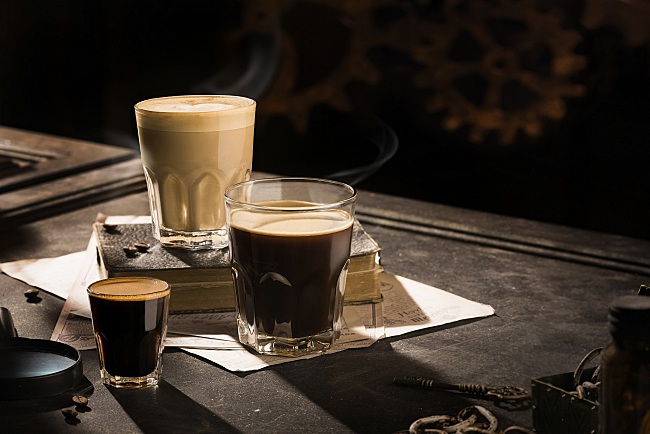Why Coffee Enthusiasts Prefer SOE Single Origin Espresso for Purity
Why Coffee Enthusiasts Prefer SOE Single Origin Espresso for Purity
Blog Article
Recognizing Coffee Beans: the Trip From Espresso to Blended Coffee Beans

The Beginnings of Coffee: A Global Perspective
While you could consider coffee as a contemporary staple, its origins trace back centuries, intertwining with societies throughout the world. The story starts in Ethiopia, where legend claims a goat herdsman named Kaldi uncovered the energizing impacts of coffee beans after observing his goats romping vigorously after eating them. This stimulated passion, bring about coffee's infect Arab traders who valued the made drink. By the 15th century, it reached Persia, Egypt, and Turkey, where coffeehouses became social hubs for discussion and culture.
As profession courses increased, coffee made its way to Europe in the 17th century, rapidly getting appeal. It changed from a magical beverage right into an everyday ritual, inspiring celebrations and intellectual exchanges. Each society included its special twist to coffee preparation, improving its history. This international journey highlights just how coffee links us, going beyond borders and joining varied practices via a straightforward bean.
Growing and Harvesting of Espresso Beans
As coffee's journey advanced, the focus changed to the growing and harvesting of details bean selections, particularly those used for coffee. You'll locate that coffee beans frequently come from Arabica or Robusta plants, each offering distinct flavors. The excellent expanding conditions include high altitudes and abundant, well-drained dirt, which boost the beans' quality.
Throughout the harvest, picking approaches differ. In some areas, workers hand-pick ripe cherries, making certain just the very best fruit goes to handling. In various other locations, mechanical harvesters are made use of, especially on bigger ranches. Timing is important; you intend to harvest when the cherries reach peak ripeness for optimum flavor.
Once collected, the beans are prepared for handling, which is necessary in identifying their last taste. Recognizing the cultivation and gathering procedures offers you understanding right into what goes right into your preferred espresso, enhancing your gratitude for each cup.
Processing Approaches: From Cherry to Bean
Since you've learnt more about harvesting coffee beans, allow's explore just how those cherries change right into the coffee beans you love. You'll see how different harvesting methods influence flavor, complied with by the essential steps of fermentation and drying. Finally, we'll damage down the milling and grading process that determines your coffee's high quality.
Collecting Techniques Discussed
When it comes to coffee, understanding harvesting strategies is necessary, given that they straight affect the flavor and quality of the beans you delight in. Selective selecting entails hand-picking just ripe cherries, guaranteeing you obtain the best high quality beans. Eventually, the option of gathering method can considerably affect your coffee experience, so it's worth understanding exactly how those beans made it to your cup.
Fermentation and Drying
After harvesting, the following actions in processing coffee beans play a considerable role in shaping their flavor. You'll discover that fermentation is essential, as it aids damage down the mucilage bordering the beans, boosting their preference account. Relying on the method, this procedure can last from a couple of hours to several days, with varying results based upon temperature and humidity.
As soon as fermentation is complete, drying adheres to, which is similarly vital. You can select from sun-drying or mechanical drying methods. Sun-drying allows the beans to soak up flavors from the environment, while mechanical drying guarantees consistent wetness levels no matter weather condition. Correct drying is necessary to stop mold and mildew and preserve the beans' quality, ultimately affecting your mug of coffee.
Milling and Grading Process
As fermentation and drying out set the stage for taste development, the milling and grading process guarantees that just the finest coffee beans make it to your mug. This stage involves eliminating the external layers of the coffee cherry, including the parchment and husk. After milling, the beans are sorted by size and weight, guaranteeing a consistent top quality. You'll find that grading helps recognize issues and categorize beans, which impacts flavor and fragrance. High-grade beans receive a greater grade, causing a richer coffee experience. When graded, the beans await product packaging and shipping, preserving their one-of-a-kind features. This careful process is necessary for delivering the exceptional preference you enjoy in every sip of your preferred brew.
Roasting Methods: Unlocking Flavor Prospective
When you roast coffee beans, the technique you select can substantially impact the flavor profile. check it out Comprehending the partnership in between time, temperature, and toasting techniques is vital to exposing the potential of your brew. Allow's explore just how these components integrated to develop the best mug.
Roasting Methods Described
While you might believe that all coffee toasting approaches yield the exact same outcomes, the fact is that each technique exposes distinct taste potentials in the beans. You my site can pick in between approaches like drum roasting, air roasting, or perhaps typical frying pan roasting. Drum roasting makes use of a rotating drum to equally distribute warmth, improving caramelization and producing a balanced flavor. Air roasting, on the various other hand, flows warm air around the beans, advertising a lighter roast with pronounced acidity. Frying pan roasting allows for hands-on control but calls for continuous focus to prevent burning. Each technique has its subtleties, so try out different strategies can aid you discover the excellent roast that straightens with your preference preferences. Delight in the trip of discovering your suitable cup!

Effect On Taste Account
Different roasting methods not only affect the process yet additionally significantly impact the taste profile of the coffee beans. Dark roasts, on the other hand, bring out strong, smoky flavors, sometimes masking the bean's distinct features. Understanding these subtleties helps you appreciate the virtuosity behind your mug of coffee, improving your overall experience with every sip.
Time and Temperature Aspects
To release the complete flavor capacity of coffee beans, both time and temperature level during the roasting process play considerable roles. When toasting, you'll find that greater temperatures can swiftly develop tastes, however if you rush it, you could wind up with scorched notes. Conversely, lower temperature levels permit a much more progressive flavor development, showcasing the beans' unique attributes.

Timing is simply as essential; expanding the roast also long can lead to a loss of acidity and illumination, while also brief a roast may leave the beans underdeveloped. Locating that pleasant place needs practice and experimentation. By changing these variables, you can disclose the abundant, complicated tastes concealed within each bean, creating an absolutely amazing coffee experience.
The Art of Mixing: Crafting Special Coffee Accounts

Start read what he said by picking a base coffee that supplies a strong foundation. Then, choose complementary beans to enhance specific flavor notes. As an example, a bright Ethiopian bean can bring fruitiness, while an abundant Brazilian coffee adds body. Experimentation is key-- don't be worried to readjust ratios until you discover your perfect account.
As you mix, maintain in mind that each combination narrates. You're not simply making coffee; you're creating an experience. Take your time, taste regularly, and appreciate the journey of finding your trademark mix - Single Origin Espresso.
Brewing Techniques: How Prep Work Influences Flavor
Mixing coffee opens up a domain of flavor opportunities, however how you brew that blend can significantly influence your final cup. On the various other hand, a pour-over highlights the coffee's quality and brightness, ideal for showcasing fragile notes.
Coffee, with its high pressure, generates a focused shot that accentuates sweet taste and crema. If you choose a lighter mixture, take into consideration a chilly brew technique; it yields a smooth, much less acidic preference.
Adjusting variables like water temperature level, grind dimension, and make time can change your coffee's account. Accept the art of brewing to discover the flavors hidden in your coffee blends.
The Future of Coffee: Sustainability and Advancement
As the coffee market develops, sustainability and technology are becoming important for dealing with ecological obstacles and meeting consumer demands. You'll notice that even more coffee companies are adopting green methods, from sourcing beans morally to implementing sustainable farming techniques. These changes not just help the planet but also improve the top quality of the coffee you appreciate.
You could see advancements like biodegradable product packaging and water-saving brewing approaches that minimize waste. Advanced innovation, such as blockchain, is also ending up being prominent, ensuring openness in the supply chain, which enables you to map your coffee back to its beginnings.
On top of that, spending in local communities and supporting farmers via fair trade initiatives fosters a much more lasting coffee ecological community. As you drink your next cup, keep in mind that your selections can add to a brighter future for coffee. By choosing sustainable brands, you're not simply appreciating a beverage; you're making a positive influence on the world.
Regularly Asked Inquiries
What Is the Difference In Between Arabica and Robusta Beans?
Arabica beans are smoother, sweeter, and have a greater acidity, while robusta beans are more powerful, much more bitter, and consist of even more high levels of caffeine. When brewing your coffee., you'll discover these distinctions in taste and aroma.
How Does Altitude Affect Coffee Bean Taste?
Elevation impacts coffee bean taste considerably. Greater altitudes produce beans with brighter acidity and complicated flavors, while lower elevations commonly produce beans that are heavier and less nuanced. You'll see these differences in your cup!
What Are the Wellness Perks of Drinking Coffee?
Drinking coffee can improve your power, enhance psychological emphasis, and also boost physical efficiency. It's rich in antioxidants, may decrease the danger of certain diseases, and can promote a much healthier metabolism when consumed in small amounts.
Can Coffee Beans Be Recycled for Brewing?
Yes, you can recycle coffee beans for brewing, yet the flavor might be weak. If you appreciate experimenting, attempt reusing them in different means, like cold mixtures or contributing to smoothies for an added kick.
Exactly how Should I Store Coffee Beans for Freshness?
To maintain your coffee beans fresh, keep them in an airtight container in a cool, dark area. Stay clear of revealing them to warmth, wetness, or light, as these factors can promptly deteriorate their flavor and fragrance.
Recognizing Coffee Beans: the Journey From Espresso to Blended Coffee Beans.
Currently that you've learned regarding collecting coffee beans, allow's check out how those cherries transform right into the coffee beans you like.When you roast coffee beans, the technique you choose can considerably influence the flavor account - Single Origin Espresso.While you might assume that all coffee roasting techniques produce the exact same outcomes, the fact is that each technique exposes unique flavor potentials in the beans.Various toasting techniques not just influence the procedure but additionally greatly impact the flavor profile of the coffee beans
Report this page